Why Your Peperomia Dropping Leaves? Identifying Common Causes Of Peperomia Leaves Falling
Peperomia plants are popular houseplants known for their beautiful foliage. However, it can be disheartening to see your peperomia start to droop and drop its leaves. There are several common causes for this issue, including overwatering, underwatering, insufficient light, low humidity, extreme temperatures, and pests. Identifying the specific cause of your peperomia’s leaf drop is crucial for finding the right solution and preventing further damage to the plant.
Key Takeaways:
- Peperomia plants can drop leaves due to various reasons, including overwatering, insufficient light, low humidity, extreme temperatures, and pest infestation.
- Providing indirect light and maintaining the right humidity levels can help prevent peperomia leaf drop.
- Proper watering practices, avoiding overwatering or underwatering, are essential for maintaining healthy peperomia plants.
- Protecting peperomia plants from extreme temperatures and avoiding fertilizer application mistakes can also prevent leaf drop.
- Regularly inspecting and treating peperomia plants for pests and diseases is crucial for their overall health and leaf retention.
Insufficient Light
Lack of sufficient light is a common reason for peperomia leaf drop. Peperomia plants require indirect light to produce enough food and sustain their leaves. If your peperomia is not receiving enough light, it will try to conserve energy by reducing leaf production. To remedy this issue, place your peperomia in a location where it can receive indirect light, or consider using a grow light to supplement the available light.
Proper placement is crucial for ensuring your peperomia gets the light it needs. Find a spot near a bright window but away from direct sunlight, as too much sunlight can scorch the leaves. If you don’t have a suitable location with adequate natural light, you can use a grow light specifically designed for indoor plants. LED grow lights are a popular choice as they emit the right spectrum of light for optimal plant growth.
Avoid placing your peperomia in low light areas such as dim corners or far from any windows. Remember that indirect light is key, so ensure your plant is not in the shadow of larger plants or obstructed by curtains. By providing the right amount of light, you can help your peperomia thrive and prevent leaf drop.
Table: Suitable Light Conditions for Peperomia
| Light Intensity | Location |
|---|---|
| Medium to Bright Indirect Light | Near a north or east-facing window |
| Low to Medium Indirect Light | Near a west-facing window |
| Low to Medium Indirect Light | A few feet away from a south-facing window |
Excess Watering
One of the common causes of peperomia leaf drop is excess watering. Overwatering can lead to peperomia root rot, which damages the plant’s roots and hinders their ability to absorb nutrients. As a result, the leaves start to wither and eventually drop. To prevent this issue, it is important to check the soil moisture before watering. Stick your finger into the soil up to your knuckle, and if it feels moist, wait until the top inch of soil dries out before watering again.
Proper drainage is also essential for preventing overwatering. Peperomia plants require well-draining soil to prevent water from pooling around the roots. If your peperomia is in a pot with inadequate drainage holes or sitting in a saucer filled with water, it’s time to make some changes. Repot your peperomia in a container with drainage holes and ensure that excess water can flow out freely.
| Signs of Overwatering | Prevention Tips |
|---|---|
| Yellowing leaves | Check soil moisture before watering |
| Wilted and mushy stems | Use well-draining soil |
| Foul odor or moldy smell | Allow soil to dry out between waterings |
Quote:
“Overwatering can be detrimental to peperomia plants, leading to root rot and leaf drop. It’s important to strike a balance and not drown your peperomia with excessive watering. Always check the soil moisture and provide adequate drainage to ensure the health of your plant.” – Plant Care Expert
Underwatering The Plant
Proper watering is essential for the health of your peperomia plant. Underwatering can lead to leaf drop and other issues. It is important to understand the watering needs of your peperomia to prevent this problem.
One of the key signs of underwatering is dry soil. Check the moisture levels of the soil regularly by inserting your finger about an inch deep into the soil. If it feels dry, it’s time to water your peperomia. However, be cautious not to overwater, as this can lead to root rot.
The frequency of watering depends on various factors such as the size of the pot, the type of soil, and the environment. Peperomias generally prefer to dry out slightly between waterings. As a general guideline, water your peperomia when the top inch of soil is dry. Adjust the watering frequency based on the specific needs of your plant.
When watering your peperomia, ensure that the water is evenly distributed throughout the pot. This will help prevent uneven drying of the soil and ensure that the roots receive adequate moisture. Remember to use room temperature water to avoid shocking the plant.
Table: Signs of Underwatering
| Signs of Underwatering | Possible Causes |
|---|---|
| Wilting or drooping leaves | Lack of water reaching the roots |
| Leaves that feel dry and brittle | Insufficient moisture in the soil |
| Increased leaf drop | Plant conserving energy by shedding leaves |
| Slow growth or stunted appearance | Limited access to water and nutrients |
If your peperomia is displaying signs of underwatering, adjust your watering routine accordingly. Remember to provide consistent moisture without overwatering. With proper care and attention to watering, you can help your peperomia thrive and prevent leaf drop.
Low Humidity Causes Leaf Drop in Peperomia Plants
Peperomia plants have specific humidity requirements, and low humidity levels can lead to leaf drop. These plants thrive in humid environments, and when the air in your home is dry, it can cause the leaves to curl, wither, and eventually drop. To keep your peperomia healthy and prevent leaf drop due to low humidity, it’s important to provide the right moisture levels.
To increase humidity for your peperomia, you can mist the leaves regularly. This simple practice provides a fine mist of water that surrounds the plant, creating a more humid microclimate. Additionally, placing the peperomia on a tray filled with water and pebbles can help to increase humidity around the plant. As the water evaporates, it adds moisture to the air surrounding the peperomia, providing the humid conditions it needs.
Another effective way to increase humidity is by using a humidifier. This device releases moisture into the air, ensuring a consistently humid environment for your peperomia. By providing the right humidity levels, you can prevent leaf drop and maintain the overall health of your peperomia plant.
Extreme Temperatures
Extreme temperatures can have a significant impact on the health of your peperomia plant, causing its leaves to droop and eventually drop. It’s important to understand the ideal temperature range for your peperomia and to take necessary precautions to protect it from temperature stress.
The recommended temperature range for peperomia plants is between 65 and 80 degrees Fahrenheit (18 to 27 degrees Celsius). Exposure to temperatures outside this range can cause the plant to undergo physiological stress, leading to leaf drop. To ensure your peperomia thrives, it’s crucial to provide it with a stable environment within this temperature range.
To protect your peperomia from excessive heat, keep it away from direct sunlight and heat sources like fireplaces or radiators. High temperatures can lead to the evaporation of moisture from the leaves and soil, causing the plant to become dehydrated and its leaves to droop. Placing your peperomia in a location with indirect light and good air circulation can help maintain a suitable temperature for the plant.
“Peperomia plants prefer room temperatures between 65 and 80 degrees Fahrenheit.”
On the other hand, extreme cold can also harm your peperomia. Avoid placing the plant in areas prone to cold drafts or near windows during the winter months. Frost can damage the leaves and disrupt the plant’s natural processes, resulting in leaf drop. If you live in a colder climate, it may be necessary to move your peperomia to a more temperature-controlled area, such as a greenhouse or indoors, during the winter season.
By ensuring your peperomia is kept within the appropriate temperature range and protected from extreme heat or cold, you can help prevent temperature-induced leaf drop and promote the overall health and vitality of your plant.
| Temperature Tips for Peperomia |
|---|
| Avoid exposing your peperomia to temperatures below 50 degrees Fahrenheit (10 degrees Celsius). |
| Keep your peperomia away from heat sources like radiators and fireplaces. |
| Place your peperomia in a well-ventilated area with indirect light. |
| Protect your peperomia from cold drafts and frost during the winter season. |
Common Mistakes in Fertilizing Peperomia Plants
Proper fertilization is essential for the health and growth of peperomia plants. However, many plant owners unknowingly make mistakes when it comes to fertilizing their peperomias, which can lead to leaf drop and other problems. Understanding and avoiding these common fertilizer application mistakes is crucial for maintaining the vitality of your peperomia.
One of the most common mistakes is overfertilizing peperomia plants. It’s easy to assume that more fertilizer will yield better results, but excessive amounts can actually harm the plant. Overfertilization can cause salt build-up in the soil, leading to root damage and nutrient imbalances. As a result, the peperomia may experience leaf yellowing and drop. To avoid this, follow a proper fertilizing schedule for your peperomia, using a diluted liquid fertilizer specifically formulated for houseplants. Slow-release pellets can also be a good option to regulate the fertilizer dosage.
Additionally, it’s important to be mindful of the timing and frequency of fertilization. Peperomias should not be fertilized during the winter months when their growth slows down. Fertilizing during this period can cause the plant to allocate energy towards new growth, leading to stress and potential leaf drop. Instead, focus on fertilizing during the active growing season, typically in spring and summer. Remember to always follow the manufacturer’s instructions regarding dosage and frequency.
Proper Fertilization Schedule for Peperomia Plants
| Season | Fertilization Frequency | Recommended Fertilizer |
|---|---|---|
| Spring | Every 4-6 weeks | General-purpose liquid fertilizer diluted to half strength |
| Summer | Every 2-4 weeks | General-purpose liquid fertilizer diluted to half strength |
| Fall | Every 6-8 weeks | Do not fertilize |
| Winter | Do not fertilize | Do not fertilize |
Infestation By Insects, Pests, And Diseases
I have learned that one of the main culprits behind peperomia leaf drop is infestation by insects, pests, and diseases. These unwanted guests can wreak havoc on your plant, causing the leaves to wither and fall off. Common pests that can infest your peperomia include fungus gnats, spider mites, and aphids. These pests feed on the plant’s sap, weakening the leaves and leading to their eventual drop.
To treat peperomia pests, there are a few options you can consider. Using insecticides like neem oil or insecticidal soaps can effectively get rid of these pests. However, it is important to follow the instructions on the product label and apply the treatment safely. You can also manually remove the pests by wiping or spraying them off with a mixture of water and mild soap. Regularly inspecting your peperomia for signs of pests and promptly treating any infestations is crucial to prevent further damage to your plant.
In addition to pests, diseases can also cause leaf drop in peperomia plants. Common diseases that affect peperomia include powdery mildew and leaf spot. These diseases can be caused by fungal or bacterial infections and can lead to the discoloration and wilting of leaves. To prevent these diseases, it is important to practice good hygiene by removing dead leaves and maintaining a clean environment for your plant. Avoid overwatering, as excessive moisture can create a favorable environment for fungal growth. If you notice signs of disease, it is best to promptly treat your peperomia with appropriate fungicides or bactericides to stop the spread of the infection.
Preventing pest infestation and disease in your peperomia is essential for maintaining the health and beauty of your plant. Besides treating any existing pests or diseases, it is crucial to take preventive measures. These include regularly inspecting your plant for signs of pests, practicing good hygiene, and providing optimal growing conditions. By addressing these issues and ensuring your peperomia is well-cared for, you can help prevent pest infestation and disease, allowing your plant to thrive and keep its lush foliage.
FAQ
What are the common causes of peperomia leaves falling?
The common causes of peperomia leaves falling could be due to overwatering or underwatering. When you water the plant excessively, it can cause the leaves to drop. Similarly, if the plant doesn’t get enough water, the leaves can turn yellow and fall off. It’s important to find a balance in watering your peperomia plant.
How can I prevent peperomia leaves from falling?
To prevent peperomia leaves from falling, ensure that you water the plant adequately. Overwatering or underwatering can cause the leaves to fall. Also, make sure the plant is getting the right amount of light and is not exposed to extreme temperatures.
What are some common peperomia pests that can cause leaf drop?
Common pests that can cause peperomia leaf drop include spider mites, mealybugs, and whiteflies. These pests can cause the plant’s leaves to turn yellow and eventually fall off. Regularly check your plant for these pests and treat the plant accordingly to maintain healthy leaves.
Why do my peperomia leaves droop?
Peperomia leaves might droop due to lack of water or exposure to direct sunlight. If the leaves of your beloved peperomia plant are drooping, try adjusting the watering schedule and the plant’s location.
What causes peperomia leaves to turn yellow?
Overwatering is a common cause of peperomia leaves turning yellow. When you water the peperomia excessively, it can lead to the dropping of leaves and cause the leaves to turn yellow.
How can I care for my peperomia houseplant to prevent leaf drop?
Caring for peperomia plants involves providing them with the right amount of water, light, and temperature. Overwatering or underwatering can cause the leaves to drop. Also, ensure that your peperomia plant is not exposed to direct sunlight as it can cause the leaves to droop.
What are some common peperomia problems that lead to leaf drop?
Some common peperomia problems that can lead to leaf drop include overwatering, underwatering, exposure to direct sunlight, and pest infestation. These factors can cause the leaves to fall and turn yellow.
What diseases can cause drooping in peperomia?
Diseases such as root rot can cause drooping in peperomia. Root rot is often a result of overwatering. If you notice your peperomia leaves drooping, check the roots for any signs of rot and adjust your watering schedule accordingly.







